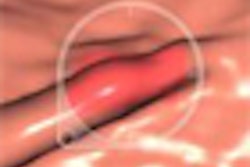Computer-aided detection (CAD) for virtual colonoscopy, while good at detecting rounded lesions that can signal the presence of colorectal cancer, is less adept at finding flat lesions or achieving high sensitivity in the hands of less experienced readers, according to a study presented at the Society of Gastrointestinal Radiologists (SGR) symposium last week.
Dr. Philippe Lefere, a radiologist at Stedelijk Ziekenhuis in Roeselare, Belgium, and co-founder of the Virtual Colonoscopy Teaching Centre in Belgium, presented the results.
"The adaptation of the CAD algorithms to detect flat lesions with [virtual colonoscopy (also known as CT colonography or CTC)] is mandatory," Lefere told the workshop attendees at the Carlsbad, CA, conference. "The system is designed for the detection of round lesions. The system tries to eliminate false positives. This can be a problem."
CAD has been touted as the answer to the hoped-for public rush to colonoscopy made painless by CT. Although the rush hasn't quite materialized, there have been fears of radiologists being buried under virtual stacks of VC exams from asymptomatic screening patients.
While CAD is a largely effective and useful tool, finding 84% of 10-mm lesions in the 2008 American College of Radiology Imaging Network (ACRIN) study by Johnson et al, Lefere stressed that CAD was most useful as a second or concurrent reader in the hands of an experienced reader.
"When we look at the studies, we see very good results in some, but there are also studies with very bad results," Lefere said. "We know sensitivity rapidly decreases as the lesions get smaller."
The ACRIN study found that lesions 5 mm and smaller were detected 59% of the time.
Because of the relatively high numbers of false positives detected by CAD, combined with the relative rarity of the disease, readers incorporating CAD into their toolkits need to be experienced, not just trained, Lefere argued.
"We need to read 8,000 to 10,000 images to see our first polyp," he said. "There is a low prevalence of disease. A day of training is not sufficient to get optimum performance."
In the hands of novice readers, CAD significantly improves performance -- and lengthens reading time, Lefere said, citing studies by Halligan et al and Petrick et al. But even with CAD, experienced readers still detected at least 10% more polyps than novices. And CAD cost readers in specificity.
When searching for flat lesions, however, CAD's false-positive rate quadrupled in the Taylor et al study published in 2008 (European Radiology, August 2008, Vol. 18:8, pp. 1666-1673). Lefere also cited a 2009 study by Park and colleagues where CAD sensitivity for flat lesions was 16% lower than that of experienced human readers (American Journal of Roentgenology, July 2009, Vol. 193:1, pp. 70-78).
"You really need to be experienced to detect flat lesions," Lefere said. "Unfortunately, CAD has a human eye. It is now clear that CAD should target flat lesions. Strangely shaped and sometimes easily detected lesions are dismissed as well."
CAD should never be the first reader, according to Lefere. And CAD doesn't teach novice readers, though novice readers should be trained on CAD to incorporate it into the reading process.
But even with those concerns, Lefere said that CAD is an excellent tool in the hands of experienced readers, and with further development, it should play a very useful role in mass screening for colorectal cancer.
"We must work to reduce false positives and to make CAD better for detecting flat lesions," Lefere said. "CAD is not the Holy Grail, but with improved performance it will be an essential part of the diagnostic process."



















